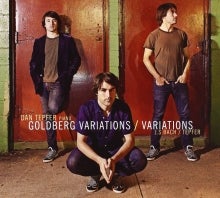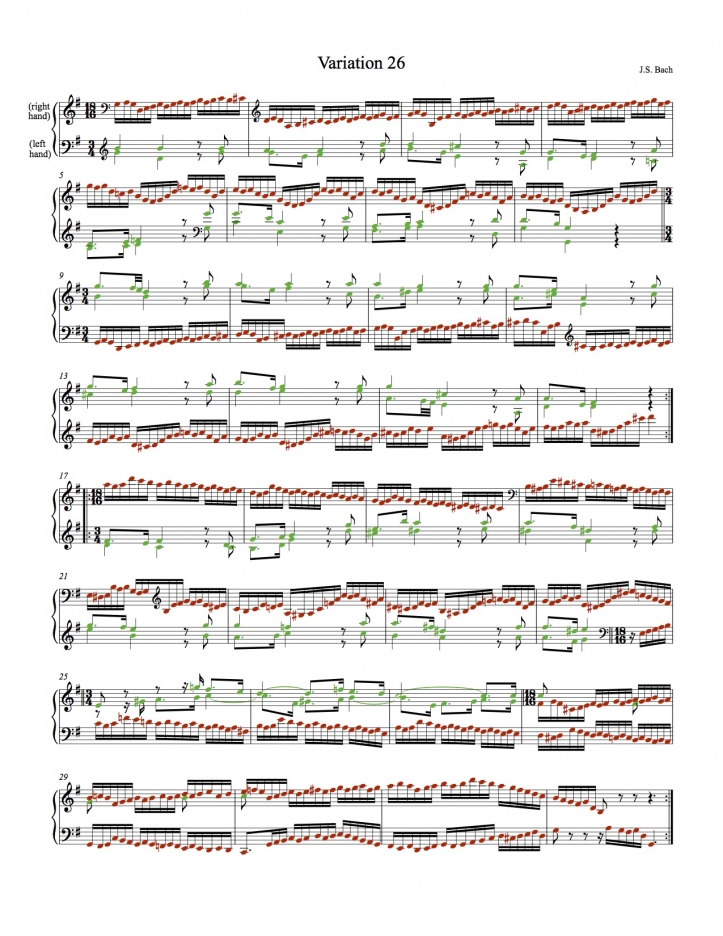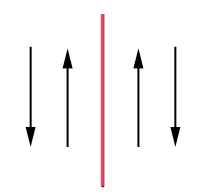Doing it Backwards: My Unexpected Goldberg Variations (Part II)

Editor's Note: Part I of this piece can be read here.
To make a long story short, I recorded what eventually became Goldberg Variations / Variations three times. Once as I’d been performing it, with fewer than half the Variations and long, rambling improvisations. Then, when I realized presenting only part of a work so whole as the Goldbergs to the world would be an embarrassment, as a much-too-long and obscure investigation into all the Variations, with a non-linear structure and a speculative tone throughout. And finally, once I realized that the purity and coherence of the Goldbergs called out for the most simple and clear structure possible, the way it finally ended up, with each of the 30 movements alternating with an improvisation of similar length, closely linked to the preceding Variation.
Since I essentially learned to play the second half of the Goldbergs while I was recording it, I started to think of the project less as a record of a live performance and more as a conceptual work that might end up only existing as a recording. There are, after all, many electronic and pop artists who never perform their work live. Recorded music can be a destination of its own.
The recording process was a powerful learning experience for me. Suddenly my weaknesses of articulation and phrasing, when I played Bach’s notes, couldn’t be ignored (as they could so easily when I practiced at home, or even when I performed). Alone in the Yamaha space, often late into the night, I recorded take after take of the Variations, and didn’t shy away from editing the best portions together. Glenn Gould did plenty of editing, I reasoned, so why couldn’t I? (I conveniently ignored the fact that he, at least, was more than capable of performing the work in front of an audience). Similarly, the recording process brought out all the structural, emotional and technical faults of my improvisations. As I advanced through the stages of the recording process, it became clear to me that the only way they could hope to stand up next to the beauty and perfection of the Variations was if they lost most of the indulgence I’d been allowing them to have. They needed to be concise and focused; they needed to get to the point, all while remaining personal. I started to develop explicit strategies. I realized, for example, that I was capable of improvising my own canons, as long as I kept them fairly rudimentary. I realized that many of the virtuosic Variations stemmed from a very restricted amount of material, and tried to find ways to improvise with a similarly limited set of ideas. I saw that Bach gave himself considerable license in the way he navigated the I-I-V || V-vi-I harmonic framework that all the Variations share, and let myself take my own varied pathways through the changes. I researched the last Variation, the Quodlibet, learned the words to the folk songs it uses as its melodic material, and substituted two jazz tunes I love as material for my improvised response. I gradually went from an implicit, alchemical relationship with the Variations to a much more precise and explicit one. And to my surprise, I gradually saw the project turn into something that felt like it had an integrity of its own.
It’s hard to record improvisations. There’s always the possibility that the next take will be better—it’s hard to stop. And yet as I recorded and re-recorded my responses to Bach, I began to recognize a flag that would occasionally go up in my mind, on good days, saying “this one’s good enough”. At first it was only one of my improvisations that felt that way, but I knew I had found a tone that rang true. My goal became to extend that tone, that feeling. I found it in another, then another, and later, in most of them (but not quite all). Saxophonist and producer Ben Wendel came in to help me choose the final takes, and suddenly I had a 62-track, 78-minute solo piano record that didn’t fit into any record-store genre category.
When it came out, at the end of 2011, I figured I would play a couple CD-release concerts and get back to touring with my trio or playing duo with saxophonist Lee Konitz, with whom my musical relationship had been growing. But to my surprise, critics either absolutely loved it (many of them) or loathed it with a passion (a few of them), and it started to take on a life of its own. After the Wall Street Journal ran a smart and generous feature, it even—surprisingly—started to sell.
For the album release, I played the full first half of the variations for the first time, from memory, and it felt like the hardest thing I’d ever done in my life, like teetering on the edge of a precipice from beginning to end. I played the Paris CD-release gig at the Sunside, a small jazz club, and an agent heard me there who decided to take a chance on me. Soon he had booked a long fall tour for me in surprisingly large venues in France, and it dawned on me that it just wouldn’t be good enough to play only half of the record. I sublet my Brooklyn apartment, traveled to Cuba, and for two and a half weeks studied percussion in the morning and memorized Goldbergs in the afternoons, away from cell phones, internet and acquaintances. An inexperienced performer of classical works, this was slow work for me, but I found it intensely rewarding. The act of memorizing forced me to make sense of the Variations, to organize them in my mind in a way that I hadn’t had to in the recording process. Bach’s economy became all the more apparent, as did the many-fold symmetries that govern the entire work, from the structural to the physical.
Bach was a lover of symmetry. If most of us can agree that symmetry is important in aesthetics—people tend to prefer symmetrical faces to asymmetrical ones—Bach took the idea to the extreme. At the physical level, in almost every variation as well as the majority of his other keyboard works, both hands get treated with exacting evenness, as if he wanted the interpreter of his music to fully appreciate the symmetry of his own body, from his hands to the hemispheres of his brain. It’s not so much that the music is equally difficult for the left hand as it is for the right, although that’s part of it: it’s that to play Bach’s music well, one is obligated to bring the same amount of melodic consciousness to the left hand as the right. This is not the case in keyboard music by most other composers, which tends to heavily favor the higher register of the right hand. I’ve always resisted redistributing the voices of the Variations between the hands for this reason, even though it’s fairly common practice to do so in order to reduce hand crossing. To me, the experience of physical symmetry is an essential part of the piece.

At the structural level, the Goldbergs exhibit symmetries from the smallest to the largest scales. At the smallest, Bach is constantly playing with inversion, one example being the 16th-note runs that begin the first and second halves of Variation 26 above, strict mirror-images of each other.

At mid-scale, the rising or falling direction of the canonic intervals offers its own symmetries. Variation 24, for example, starts as a canon at the falling octave, switches to a rising octave on either side of its middle, and ends at the falling octave again, showing palindromic symmetry in its structure.

At the largest scale, the I-V || V-I binary form of the Aria and the variations, with its central axis of symmetry, reflects the symmetry of the whole work, which similarly starts and ends in the same place (the Aria) and is split at its midpoint in the silence between the 15th variation and the 16th variation, the only to be titled “Overture”—a new beginning. The division of the Aria into 32 bars similarly reflects the work’s division into 32 movements, connecting the part to the whole. It’s easy to see this as an analogy of our existences: from ashes to ashes, with life in between. No wonder, then, that the Goldbergs are often described as expressing every possible shade of human emotion.
By the fall of ’12, I had coerced so many friends into letting me run through the program for them at home in casual performances—always with their share of little disasters—that I was beginning to get an idea of what I was up against. Performing the Goldbergs in public is not only a musical and spiritual challenge; it’s a physical and mental marathon, too. There’s no place to hide in Bach’s limpid music—it will immediately reveal and magnify any lapses in concentration, any tightening up of the body, any fear. And alternating between my role as interpreter of the written text and my role as in-the-moment improviser only made the task harder, constantly jolting me out of the possibility of getting ‘in the zone’ as I switched between mental states. To say I was terrified is an understatement, but the truth is that I’ve always been a thrill-seeker, in sports just as much as in music. So the terror had its own attraction. My dad called me an adrenaline junkie. And I think it’s fair to say that it’s during the fall tour that I started to learn what it really means to perform the Goldbergs. The tour was well received, but after I came home to Brooklyn, I heard Piotr Anderszewski play Bach’s English and French Suites at Carnegie Hall and was struck with a mirror-neuron-like physical feeling for how direct and unencumbered his relationship to the piano was. I realized that I had only fleetingly truly relaxed my body into the keyboard when I was playing Bach’s music on the road. A number of people had noted, in fact, how different my body language was between the variations and my improvisations. The fear of a memory slip or technical slip-up kept my body on edge.
Much of my work since then has been on diminishing the sensation of fear. I realized, for example, that focusing my attention on rhythm and how it manifested in my body was a big help. It gave the notes a context to sit in and directed my attention forward, slightly into the future and away from the paralyzing present. I also realized the obvious, which is that the more I deepened my knowledge of Bach’s text, the more confidence I had when presenting it to an audience. Weeks after a solo performance in Vancouver, on the tail end of a duo tour with Ben Wendel, with whom I had just released a duo record, I got a call from an accomplished baroque harpsichordist who specializes in Bach and had heard my concert there. While he wished me good luck, he told me in no uncertain terms that my performance of the canons needed work. Why would you only bring out the top voice, he asked, when they’re all equally important? I didn’t have the heart to explain that I’d bring them all out if I could—that I was holding on for dear life out there. But I did take his cue and returned to Bach’s score with increased humility, practicing singing the interior voices of the canons while I played the others on the piano, or at other times willing myself to transpose variations to foreign keys from memory, and again at others spending hours obsessing over the exact phrasing of one short melody. Every time I opened the score, I was reminded that there is always something further to discover in Bach’s music—that the more you seek, the more you find. One thing dawned on me: when you’re starting with material of this quality, you don’t need to add anything to it. Your job is to get out of the way, to solve your interpretive problems so as to reveal the work itself as clearly as possible, like scraping mud off a diamond. I’m grateful to the pianist Simone Dinnerstein, a masterful interpreter of the Goldbergs, for generously giving me encouragement and musical advice during this time.
In the fall of ’13, a short solo tour came together on the East Coast, culminating in a show at one of my favorite New York venues, Le Poisson Rouge, a place that will present just about any style of music, from Johnny Gandelsman on solo violin to Laura Mvula with full band, as long as it’s good. Something happened on the tour—something started to click emotionally. I stopped trying so hard, started to let things be, both in the variations and my improvisations. “Don't try to make the music beautiful - it is beautiful; just let it out”, the beloved piano guru Sophia Rossoff had told me, and I slowly began to understand what she meant. And after the gig at Le Poisson Rouge, a man introduced himself to me, warmly, as Anthony Tommasini of the New York Times. A day later there was a glowing review in the paper, and suddenly the record was selling better on Amazon than Justin Timberlake and Lady Gaga, if only for a brief while. In the following days I got calls from some of the best presenters and festivals in America inviting me to perform.
What astonishes me about this is that the same critic, a fierce and erudite expert on classical music, may very well have panned me if he had heard me two years earlier. It took me that long to even begin to understand what was at stake when performing this music in front of an audience. And in those two years, my rising standards for what makes an acceptable performance of Bach started to spread laterally to the other types of music I was making, from my composing to my improvising. Dealing with Bach so frequently and—it felt—so intimately made all but the most well structured and meaningful new music feel lacking in comparison.
Looking back, as I prepare for solo shows at the Ravinia Festival, SF Jazz Center and Wigmore Hall in London, I’m amazed any of this happened at all. From many perspectives, I’m sure it would seem that I developed my Goldberg Variations / Variations project exactly backwards. But I didn’t know any better, and that’s probably why it ended up coming into existence—I just followed my nose. Above all, I’m grateful for the opportunity, a truly unexpected one for me, to engage much more deeply than I thought I ever would with one of music’s greatest geniuses, and to let Bach teach me.
Born in Paris to American parents, “tremendously gifted” (LA Times) pianist-composer Dan Tepfer has translated his bi-cultural identity into an exploration of music that ignores stylistic bounds. His 2011 Goldberg Variations / Variations, which pairs his performance of Bach’s work with improvised variations of his own, has received broad praise as a “riveting, inspired, fresh musical exploration” (New York Times). He has worked with the leading lights in jazz, including extensively with saxophone luminary Lee Konitz, while releasing seven albums as a leader. As a composer, he is a recipient of the Charles Ives Fellowship from the American Academy of Arts and Letters for works including Concerto for Piano and Winds, premiered in the Prague Castle with himself on piano, and Solo Blues for Violin and Piano, premiered at Carnegie Hall. Bringing together his undergraduate studies in astrophysics with his passion for music, he is currently working on integrating computer-driven algorithms into his improvisational approach. Awards include first prize and audience prize at the Montreux Jazz Festival Solo Piano Competition, first prize at the East Coast Jazz Festival Competition, and the Cole Porter Fellowship from the American Pianists Association. His recent soundtrack for the independent feature Movement and Location was voted Best Original Score at the 2014 Brooklyn Film Festival. Learn more at www.dantepfer.com.





